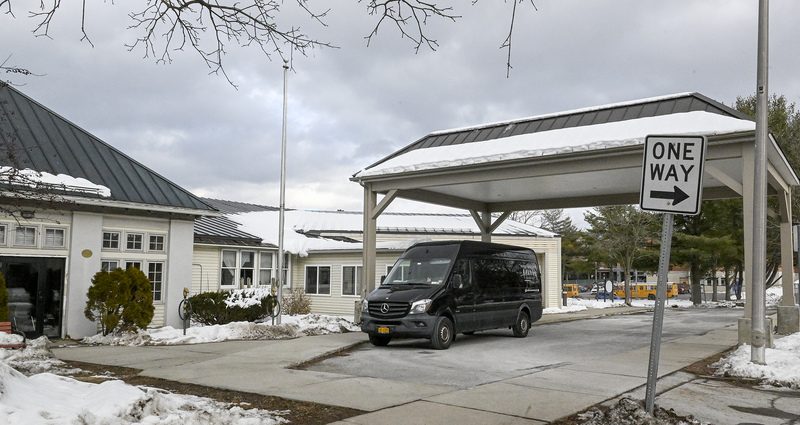February 27, 2023 by Darren Pasek (’25)
In October 2022, the city finally announced plans that Saratoga Springs would have a permanent low-barrier homeless shelter. Up until October, the city was working with Shelters of Saratoga (SOS) to repurpose the current senior center at 5 Williams Street. The city already owns this building and SOS was prepared to manage the project. Considering the dire need for a designated shelter in Saratoga, everything seemed like a perfect fit. This location, however, is behind Spa Central Catholic (SCC) school–right across Hamilton Street. Naturally, some parents and involved members of SCC found themselves in opposition to this location.

The city expected this to happen, so they set up meetings with the school’s administrators and parents to discuss their concerns. Many of the parents objected to the “low-barrier” principle because “low-barrier” means that the shelter does not screen their inhabitants until a certain number of days after entry (usually around 14 days, but the numbers set by the city were still tentative). Therefore, someone could stay in the shelter while using intoxicants, or they could be ex-convicts/sex offenders without anyone knowing.
The fears of this happening of course have logical merit but, across the country, communities that have adopted the housing-first approach have been more successful than those that prioritize screening. For example, a 2021 study found that housing-first approaches nationwide reduced homelessness by 88% and increased housing stability by 41%.
Many opponents of 5 Williams Street acknowledge this, but still would prefer the shelter didn’t go near their school. Many of these same people insist that a shelter is necessary for the city. As hypocritical as that is, it is a well-observed phenomenon of human nature called “not in my backyard” wherein people love the concept of something, but only if actually dealing with it is someone else’s problem.
But listening to SCC’s cries of “not in my backyard” isn’t fully possible. The problem of selecting a location for the shelter lies in what buildings the city owns and where the shelter would be helpful to people. For instance, the city owns lots of property on Weibel Avenue, but homeless people inhabit downtown where city aid and services are, so a shelter on Weibel Avenue would be less effective than one nearer to downtown.
Through all this debate over location, tensions grew, and some SCC parents even threatened members of the city council as well as administrators at SOS. The uproar was so unbearable that SOS pulled out of the whole deal, essentially vetoing the project from moving forward at that location. Now it has become clearer that Shelters of Saratoga’s future plans will focus on Cold Blue, a service for housing the homeless when it’s below 32 degrees.
Saratoga may not see this necessary permanent homeless shelter for years. Considering how vital SOS is to this process, and how difficult it is to find a location that is remotely agreeable for community members while being supportive to those who may need it, the project requires a lot of alignment.
The way that people reacted so strongly and illogically to the shelter provides a keen anecdote to the political climate of Saratoga Springs. Saratoga is a unique town in terms of its governmental structure. Essentially, the system we have is called a commissioner government. It uses cycles of two years for our elected officials, making it near impossible for substantial progress to be made legislatively. Much of the frustration against the city government, whether people realize it or not, is a result of the stagnation the commissioner system causes. This is one of two primary factors that lead to the polarizing responses to a seemingly minor political disagreement.
The other factor is a more speculative sociological trend: Saratoga (and many of its inhabitants) seem to have too few problems. When people lack a cause in their life that they need to work toward addressing, they find one. Of course, this is an extreme generalization, but this principle surely plays a role in guiding the hyper-reactionary political climate of Saratoga. This same principle is seen whenever a country goes to war and the country puts aside its internal conflicts to defeat the outside enemy. But then a decade or so later, when the war is over, they are back to fighting each other. Unless faced with a struggle, humanity finds contentedness and purpose through conflict and anger.
Saratoga Springs has a lot of people with relatively few problems (if they realize it or not), leading to many who can spend their time getting passionate (and angry) about causes that would progress better if handled with rational compromise instead of emotion. One can only hope that people in our city can re-ground themselves and realize that there is no other realistic location for the homeless shelter.
It is likely that Shelters of Saratoga and the city can repair their bond, as well as gain the agreement of opponents at some point. In fact, many of the opponents firmly support the shelter and all its qualities, but just as firmly oppose the shelter being near SCC. However, for the strides the city would like to make in aiding the unhoused population, the shelter must be in someone’s backyard.
